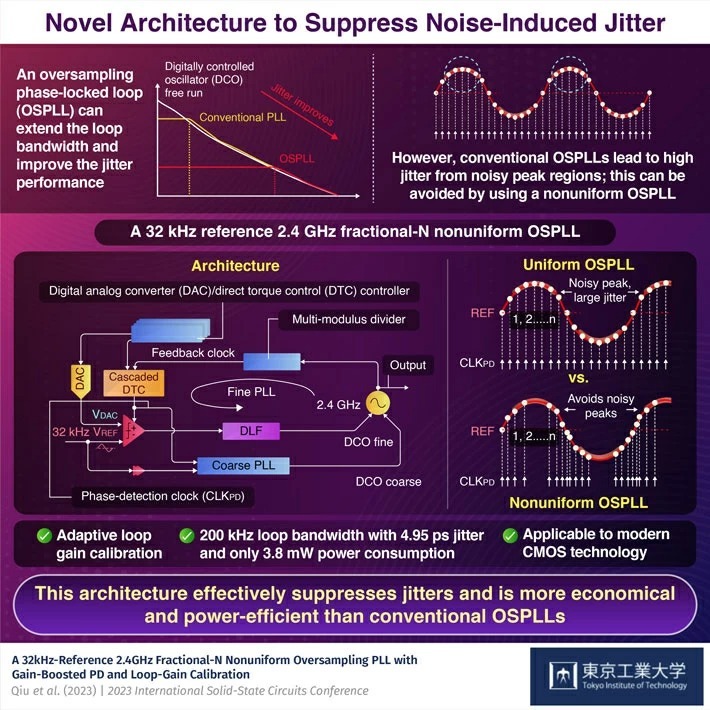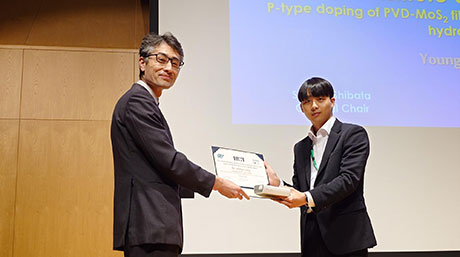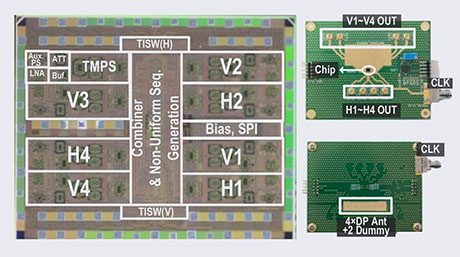Electrical and Electronic Engineering News
Novel Architecture Can Reduce Noise-Induced Jitters in Digital Technology
Jitters are a common shortcoming of modern electronic devices using a high-frequency digital signal. While oversampling phase-locked loops (OSPLLs) can expand the loop bandwidth, effectively reducing jitter, conventional OSPLLs suffer from high jitter in noisy signal peak areas. Tokyo Tech researchers have instead suggested and demonstrated a non-uniform OSPLL that can efficiently suppress jitter through adaptive loop gain calibration. This novel architecture leads to more economical and power-efficient devices than conventional OSPLLs.

The efficacy and efficiency of modern electronic devices often depend on their signal noise and jitter. Jitter is the fluctuation or deviation of the signal waveform in a high-frequency digital signal. There are many conventional methods to mitigate jitter and boost the performance characteristics of a device. One common method is to use an oversampling phase-locked loop (OSPLL). An OSPLL can extend the loop bandwidth and result in improved jitter performance.
Now, while they present many benefits, the use of conventional OSPLLs leads to high jitter from noisy peak regions, as the peak regions have a smaller gradient. The slow reference slope of a conventional 32 kHz signal introduces a large jitter and results in a larger attributed time error. This disadvantage has thus far hindered the broader use of OSPLLs. Now a team of scientists from Tokyo Institute of Technology (Tokyo Tech) have demonstrated how this can be avoided by using a non-uniform OSPLL. Professor Kenichi Okada, who led the research team, further explains the development: "Our novel over-sampling architecture provides a low-jitter, 2.4 GHz fractional-N PLL using a 32 kHz reference. The loop bandwidth of conventional PLLs is theoretically limited to 1/10th of the reference frequency, by Gardner's stability theory. This narrow loop bandwidth causes jitter degradation. Our non-uniform over-sampling PLL can increase the loop bandwidth by 60 times and can efficiently suppress jitters. "
The newly ideated device architecture allows for an adaptive loop gain calibration. By automatically performing the loop gain calibration for each sampling point, the jitter can be minimized. "Our device's performance is highlighted by its 200 kHz loop bandwidth with 4.95 ps jitter. At these parameters, the device only consumes 3.8 mW of power. Moreover, it can be integrated with CMOS technologies, making it a particularly attractive prospect for the ever-growing electronics industry, " adds Junjun Qiu from Tokyo Tech, the lead author of their study, which is published in 2023 International Solid-State Circuits Conference. This paradigm-shifting architecture also more economical and power efficient than conventional OSPLLs, owing to reduced jitter and a higher and cleaner signal.
We cannot wait to see what's in store for these devices and how they will impact the next generation of CMOS sensors, power devices, and the plethora of other applications that will benefit from more power efficient PLLs.
- Reference
| Authors : | Junjun Qiu1, Wenqian Wang1, Zheng Sun1, Bangan Liu1, Yuncheng Zhang1, Dingxin Xu1, Hongye Huang1, Ashbir Aviat Fadila1, Zezheng Liu1, Waleed Madany1, Yuang Xiong1, Atsushi Shirane1, Kenichi Okada1 |
| Title : | A 32kHz-Reference 2.4GHz Fractional-N Nonuniform Oversampling PLL with Gain-Boosted PD and Loop-Gain Calibration |
| Conference : | 2023 International Solid-State Circuits Conference |
| DOI : | N/A |
| Affiliations : |
1 Tokyo Institute of Technology, Tokyo, Japan |
|
* Corresponding author's email: okada@ee.e.titech.ac.jp |
|
- Improving the Performance of Satellites in Low Earth Orbit | Tokyo Tech News
- New Transmitter Design for Small Satellite Constellations Improves Signal Transmission | Tokyo Tech News
- New and Improved Multi-Band Operational Receiver for 5G New Radio Communication | Tokyo Tech News
- Efficient Satellite Downlink with a Ka Band Dual Circular Polarization Transmitter | Tokyo Tech News
- Electricity and Data Over-the-Air: The Simultaneous Transmission of 5G and Power | Tokyo Tech News
- Introducing a Transceiver that Can Tap into the Higher Frequency Bands of 5G Networks | Tokyo Tech News
- Novel Fast-Beam-Switching Transceiver Takes 5G to the Next Level | Tokyo Tech News
- Lean and mean: Maximizing 5G communications with an energy-efficient relay network | Tokyo Tech News
- Pushed to the Limit: A CMOS-based transceiver for beyond 5G applications at 300 GHz | Tokyo Tech News
- Greater Connectedness in Remote Areas: A Ka-band Transceiver for Satellite Communications | Tokyo Tech News
- Researchers develop a compact 28-GHz transceiver supporting dual-polarized MIMO | Tokyo Tech News
- Smallest all-digital circuit opens doors to 5 nm next-gen semiconductor | Tokyo Tech News
- A more accurate, low-cost 39 GHz beamforming transceiver for 5G communications | Tokyo Tech News
- Gearing up for 5G: A miniature, low-cost transceiver for fast, reliable communications | Tokyo Tech News
- Kenichi Okada - Wiring the world wirelessly | Research Stories | Research
- Prof. Kenichi Okada awarded the 18th DOCOMO Mobile Science Award | Tokyo Tech News
- Okada Lab.
- Kenichi Okada | Researcher Finder - Tokyo Tech STAR Search
- Electrical and Electronic Engineering Graduate Major|Education|Department of Electrical and Electronic Engineering, School of Engineering
- Electrical and Electronic Engineering Undergraduate Major|Education|Department of Electrical and Electronic Engineering, School of Engineering
- Latest Research News
School of Engineering
—Creating New Industries and Advancing Civilization—
Information on School of Engineering inaugurated in April 2016
Further Information
Professor Kenichi Okada
School of Engineering, Tokyo Institute of Technology
Email okada@ee.e.titech.ac.jp






